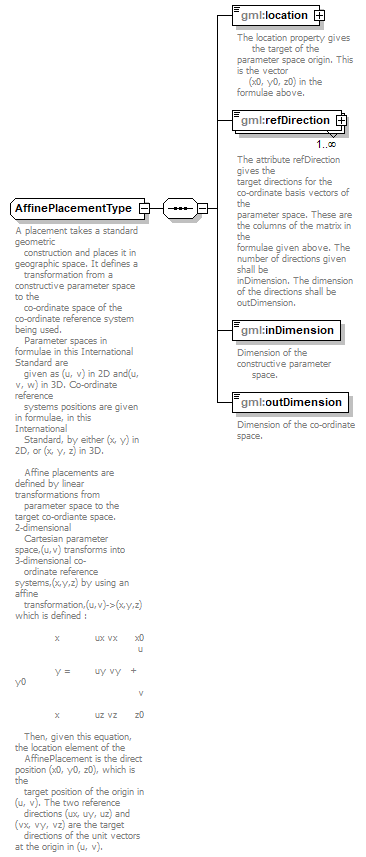| diagram |  |
||
| namespace | http://www.opengis.net/gml | ||
| children | gml:location gml:refDirection gml:inDimension gml:outDimension | ||
| used by |
|
||
| annotation |
|
||
| source | <xs:complexType name="AffinePlacementType"> <xs:annotation> <xs:documentation>A placement takes a standard geometric construction and places it in geographic space. It defines a transformation from a constructive parameter space to the co-ordinate space of the co-ordinate reference system being used. Parameter spaces in formulae in this International Standard are given as (u, v) in 2D and(u, v, w) in 3D. Co-ordinate reference systems positions are given in formulae, in this International Standard, by either (x, y) in 2D, or (x, y, z) in 3D. Affine placements are defined by linear transformations from parameter space to the target co-ordiante space. 2-dimensional Cartesian parameter space,(u,v) transforms into 3-dimensional co- ordinate reference systems,(x,y,z) by using an affine transformation,(u,v)->(x,y,z) which is defined : x ux vx x0 u y = uy vy + y0 v x uz vz z0 Then, given this equation, the location element of the AffinePlacement is the direct position (x0, y0, z0), which is the target position of the origin in (u, v). The two reference directions (ux, uy, uz) and (vx, vy, vz) are the target directions of the unit vectors at the origin in (u, v).</xs:documentation> </xs:annotation> <xs:sequence> <xs:element name="location" type="gml:DirectPositionType"> <xs:annotation> <xs:documentation>The location property gives the target of the parameter space origin. This is the vector (x0, y0, z0) in the formulae above.</xs:documentation> </xs:annotation> </xs:element> <xs:element name="refDirection" type="gml:VectorType" maxOccurs="unbounded"> <xs:annotation> <xs:documentation>The attribute refDirection gives the target directions for the co-ordinate basis vectors of the parameter space. These are the columns of the matrix in the formulae given above. The number of directions given shall be inDimension. The dimension of the directions shall be outDimension.</xs:documentation> </xs:annotation> </xs:element> <xs:element name="inDimension" type="positiveInteger"> <xs:annotation> <xs:documentation>Dimension of the constructive parameter space.</xs:documentation> </xs:annotation> </xs:element> <xs:element name="outDimension" type="positiveInteger"> <xs:annotation> <xs:documentation>Dimension of the co-ordinate space.</xs:documentation> </xs:annotation> </xs:element> </xs:sequence> </xs:complexType> |
element AffinePlacementType/location
| diagram |  |
||||||||||||||||||||||||||||||||||||||
| namespace | http://www.opengis.net/gml | ||||||||||||||||||||||||||||||||||||||
| type | gml:DirectPositionType | ||||||||||||||||||||||||||||||||||||||
| properties |
|
||||||||||||||||||||||||||||||||||||||
| used by |
|
||||||||||||||||||||||||||||||||||||||
| attributes |
|
||||||||||||||||||||||||||||||||||||||
| annotation |
|
||||||||||||||||||||||||||||||||||||||
| source | <xs:element name="location" type="gml:DirectPositionType"> <xs:annotation> <xs:documentation>The location property gives the target of the parameter space origin. This is the vector (x0, y0, z0) in the formulae above.</xs:documentation> </xs:annotation> </xs:element> |
element AffinePlacementType/refDirection
| diagram |  |
||||||||||||||||||||||||||||||||||||||
| namespace | http://www.opengis.net/gml | ||||||||||||||||||||||||||||||||||||||
| type | gml:VectorType | ||||||||||||||||||||||||||||||||||||||
| properties |
|
||||||||||||||||||||||||||||||||||||||
| attributes |
|
||||||||||||||||||||||||||||||||||||||
| annotation |
|
||||||||||||||||||||||||||||||||||||||
| source | <xs:element name="refDirection" type="gml:VectorType" maxOccurs="unbounded"> <xs:annotation> <xs:documentation>The attribute refDirection gives the target directions for the co-ordinate basis vectors of the parameter space. These are the columns of the matrix in the formulae given above. The number of directions given shall be inDimension. The dimension of the directions shall be outDimension.</xs:documentation> </xs:annotation> </xs:element> |
element AffinePlacementType/inDimension
| diagram |  |
||||
| namespace | http://www.opengis.net/gml | ||||
| type | xs:positiveInteger | ||||
| properties |
|
||||
| annotation |
|
||||
| source | <xs:element name="inDimension" type="positiveInteger"> <xs:annotation> <xs:documentation>Dimension of the constructive parameter space.</xs:documentation> </xs:annotation> </xs:element> |
element AffinePlacementType/outDimension
| diagram |  |
||||
| namespace | http://www.opengis.net/gml | ||||
| type | xs:positiveInteger | ||||
| properties |
|
||||
| annotation |
|
||||
| source | <xs:element name="outDimension" type="positiveInteger"> <xs:annotation> <xs:documentation>Dimension of the co-ordinate space.</xs:documentation> </xs:annotation> </xs:element> |
XML Schema documentation generated by XMLSpy Schema Editor http://www.altova.com/xmlspy